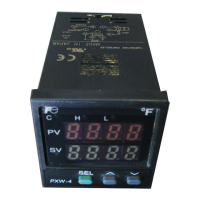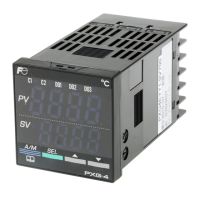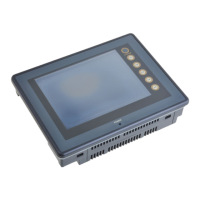19
The controller then reads the reaction of these test signals on the
process. Keep in mind that every process is different and therefore
every reaction to the test signals is different. This is why PID parame-
ters are not the same for all processes. The amplitude (L) or lag time
which is the overshoot and undershoot of the system when autotun-
ing, and the time constant (T) which is the time the process takes to
go through one On/Off cycle are measured. See diagram below.
The measurements are then used with the Autotune algorithm for cal-
culation of the proper PID parameters for the system, as shown
below, where K is the proportionality constant and S is the Laplace
operator.
K
e
-LS
(1+TS)
APPENDIX B
Manual Tuning
Tune the controller if any of the following occurs:
• The controller is installed in a new system
• The controller is used as a replacement in an existing system
• The input sensor is relocated or changed
• The output device is relocated or changed
• The setpoint is significantly changed
• Any other condition that will alter the dynamics of the system
Proportional Band
The proportional band is a band around the setpoint of the PXW where
the output is between 0% and 100%. The percentage of output is pro-
portional to the amount of error between the setpoint variable (SV) and
the process variable (PV). Outside of the proportional band the output is
either 0% or 100%
The proportional band on PXV3/PXW is equidistant from the main set-
point as illustrated below.
An example of proportioning would be a vehicle approaching a stop
sign at an intersection. If the driver were traveling at 50mph and only
applied his brakes once at the intersection, his car would skid through
the intersection before coming to a full stop. This illustrates how
On/Off control acts. If, however, the driver started slowing down some
distance before the stop sign and continued slowing down at some
rate, he could conceivably come to a full stop at the stop sign. This
illustrates how proportional control acts. The distance where the
speed of the car goes from 50 to 0 MPH illustrates the proportional
band. As you can see, as the car travels closer to the stop sign, the
speed is reduced accordingly. In other words, as the error or distance
between the car and the stop sign becomes smaller, the output or
speed of the car is proportionally diminished. Figuring out when the
vehicle should start slowing down depends on many variables such
as speed, weight, tire tread, and braking power of the car, road condi-
tions, and weather much like figuring out the proportional band of a
control process with its many variables.
The width of the proportional band depends on the dynamics of the
system. The first question to ask is, how strong must my output be to
eliminate the error between the setpoint variable and process vari-
able? The larger the proportional band (low gain), the less reactive
the process. A proportional band too large, however, can lead to
process wandering or sluggishness. The smaller the proportional
band (high gain), the more reactive the output becomes. A proportion-
al band too small, however, can lead to over-responsiveness leading
to process oscillation.
A proportional band which is correct in width approaches main set-
point as fast as possible while minimizing overshoot. If a faster
approach to setpoint is desired and process overshoot is not a prob-
lem, a smaller or narrower proportional band may be used. This would
establish an over-damped system or one where the output would
change greatly, proportional to the error. If process overshoot cannot
be tolerated and the approach to setpoint does not have to be quick, a
larger or wider proportional band may be used. This would establish
an under-damped system or one where the output would change little,
proportional to the error.

